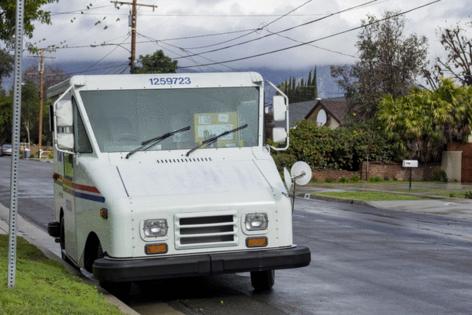GOP leaders are encouraging Pennsylvania Republicans to embrace mail-in voting. It appears to be working
Published in News & Features
Eileen Cunningham began registering voters in 2019 outside a Shop N' Go in Lincoln Place.
Ahead of the contentious 2020 presidential election, and amid a global pandemic, she noticed that her neighbors had many questions — and concerns — about where and how they should be casting their ballots.
Cunningham, secretary of the Pittsburgh Republican Committee, decided to make it her mission to find answers to all of their questions — many of which had to do with voting by mail.
"Mail-in ballots were new to everybody," said Cunningham. "Nobody in my community did them."
After years of conflicting messaging about mail-in voting coming out of the Republican party, GOP strategists in Pennsylvania are urging candidates to embrace the practice — which they say is especially important in off-cycle elections, like the one coming in November.
Mail-in voting can be a tool to increase turnout among people who normally wouldn't take the time to vote in an off-year election, when fewer people are paying attention to politics, said Vince Galko, a Republican strategist in Pennsylvania.
"Turnout is the number one factor in these elections," he said.
With two weeks left to request mail-in ballots for the November election, 240,000 Republican applications in Pennsylvania have already been approved as of Thursday (nearly 20,000 more than in the last off-year election), but Democrats are still leading the charge with nearly 646,000.
It's an improvement for Republicans, who have been reaching out to voters through local grassroots efforts and producing national ads encouraging mail-in voting in the years since 2020.
Closing the gap
Mail-in voting is not a new concept. While it hadn't become widespread until the pandemic hit, voting by mail has been part of Pennsylvania's voting system for more than 85 years, available for some members of the military, records show. By 1963, absentee voting was extended to the broader public if they had an excuse for why they couldn't vote in person.
What changed in 2019 was that a bipartisan majority in the Legislature passed Act 77, which created a mail-in voting option for Pennsylvania voters — no excuse necessary.
By 2020, mail-in voting became ever-present across the country as the COVID-19 pandemic ravaged the nation — despite President Donald Trump's claims that the voting method is riddled with fraud and would rig that election.
At that time, Democrats were far outpacing Republican efforts to make voters comfortable with mailing in their ballots.
Cunningham says that discrepancy was a major factor in Republicans losing the 2020 election.
"The Republicans fought it and Democrats embraced it," Cunningham said.
In 2020, Trump lost Pennsylvania to Joe Biden by fewer than 81,000 votes, and Biden received 1.4 million more mail-in ballots than Trump.
Republican Party leaders have been trying to close that gap since 2020.
Following Biden's 2020 win, the Trump team and Republican National Committee regrouped, running ads urging Pennsylvania voters to join the mail-in voting list and launching a website giving voters direct access to request a mail-in or absentee ballot.
Almost 60% of Democrats voted by mail in 2020, more than three times the rate of Republicans. Last year, just over one-third of Democratic votes came via mail ballots, less than twice the Republican rate.
Christopher Borick, director of the Muhlenberg College Institute of Public Opinion, explained that as many Democrats returned to the polls to vote in person following pandemic fears, Republicans were receiving messaging aiming to build confidence about mail-in voting as a way to move their numbers forward.
It seems to be working. As messaging about mail-in voting from the Republican party shifted and became more favorable toward the voting practice, it appears that voters have started to come around on the idea of casting their ballots in a new way.
But mail-in voting totals aren't the only encouraging numbers for Pennsylvania Republicans.
The party is closing the gap on their voter registration numbers, too: in the 2020 general election, there were 685,818 more registered Democrats in the state, but the most recent numbers show that there are now just 178,070 more registered Democrats as of the May 2025 primary.
Joining the 'game'
Republicans' mail-in voting outreach efforts have been crucial for encouraging unlikely voters to go through with casting their ballot for GOP candidates, Cunningham said.
In the summer, the Pittsburgh Republicans hosted postcard-writing events where volunteers sent notes to low-propensity voters asking them to apply for mail-in ballots, later following up with them ahead of the election to remind them to send them in.
"We had to join the game," she said. "Our people are getting a coherent message that they understand, and it's working."
Playing the game also meant educating Republican voters — by door-knocking and setting up tables at local festivals and sports events — about what it actually means to vote by mail.
"The challenge is getting the Republicans to put their guard down," Cunningham said. "They do not believe ... that the ballot they sent in is the one that is counted."
Since 2020, James Markley, communications director for the Pennsylvania GOP, said Republican voters are becoming increasingly open to the idea.
Take Bucks County, for example, which swung red for Trump in 2024 by fewer than 300 votes. Almost a quarter of Republicans voted by mail in the election, compared to 20.6% in 2020.
"Individuals who track their vote online and see it counted feel very safe with the process now," Markley said. "At the end of the day, you're comfortable with what you've seen work."
Contending with Trump's comments
Republican messaging about mail-in voting hasn't resonated everywhere. In Allegheny County, the percentage of Republicans voting by mail went down by 2.5 percentage points between the 2020 and 2024 general elections.
That might be because the push to embrace mail-in voting from some Republican party leaders hasn't stopped Trump from calling for mail-in voting to be eradicated.
Data indicates that Trump's core supporters might be swayed by his anti-mail-voting message. In the 2024 Republican presidential primary, 35.5% of former South Carolina Gov. Nikki Haley's votes were cast by mail, while just 13.52% of Trump's votes were mail-in, election results show.
Still, GOP strategists say it is in Republicans' best interest not to shy away from it.
"Regardless of what the president may say one day or the other on mail-in balloting, Republicans in Pennsylvania understand that it's a key part of how people vote," said Christopher Nicholas, a Pennsylvania-based Republican political consultant.
But the mixed messaging has caused some tension within the Republican party and created an "incredibly awkward dynamic," Borick said.
"They're hitting a pretty challenging headwind from their own president," he said.
Others don't see it that way.
"What he's trying to say is that in a perfect world, we would get rid of mail-in balloting," Galko said. "But Republican strategists and campaigns need to face the facts that it is here and we need to embrace it, or we're going to lose elections."
While mail-in voting remains a legal option, GOP leaders say the party should embrace it.
"Our goal is to use mail-in ballots until we can get rid of them," Cunningham said. "If we want to get rid of mail-in ballots, we have to win elections."
Voting in the November 2025 election
This election cycle, control of the Pennsylvania Supreme Court is on the ballot, which has made it a more high-profile election than in previous off-years. Republicans are hoping voters vote against retaining three Democratic justices on the bench.
Mail-in voting has emerged as a talking point from both parties, as the campaign to keep the justices on the court has made access to voting a key issue, while the "no" campaign has criticized some of the court's decisions relating to mail ballots, Borick said.
In Pittsburgh, Democrat Corey O'Connor and Republican Tony Moreno are facing off in the city's mayoral race.
Moreno said he has been encouraging people to vote by mail.
"It gives more people the opportunity to vote," he said. "I want everybody to take advantage of it."
Applications for mail-in or absentee ballots must be received by county election officials by 5 p.m. on Oct. 28. For those planning to vote in-person, polls are open from 7 a.m. to 8 p.m. on Election Day, and polling locations can be found here.
Ballot return sites are open on the last few days before Election Day, after the deadline to request a mail-in ballot has passed.
_____
© 2025 the Pittsburgh Post-Gazette. Visit www.post-gazette.com. Distributed by Tribune Content Agency, LLC.







Comments